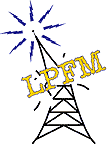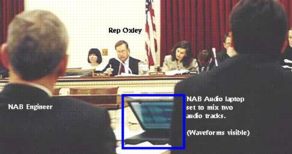There is now compelling evidence that the National Association of Broadcasters’ current lobbying effort for an outright ban on low power FM radio stations is based on corrupt and intentionally misleading scientific data. This includes information the NAB recently presented as testimony front of a Congressional subcommittee.
The NAB has fought long and hard against the FCC’s new low power FM ruling, spending millions of dollars to try and prevent the FCC from legalizing the service. It lost. Now it is trying the ultimate trump card by pulling the strings of Congress.
As part of a drive to get a “Radio Broadcasting Preservation Act” passed in both the House and Senate, it has been distributing a compact disc to members of Congress that claims to illustrate the interference low power FM stations would cause to full-power stations.
The compact disc contains a running narrative from Charles L. Jackson, the consultant engineer the NAB paid to act as its “technical expert” on the LPFM interference issue. It also contains various “test samples” of “interference demonstrations” to support the NAB’s premise.
 These demonstrations, says Jackson’s commentary, illustrate “the impact of the changes in the existing interference protection standard that radio listeners currently enjoy.” In other words, Jackson claims his audio samples of potential interference are certifiable, accurate simulations of what LPFM would sound like to listeners of current stations if implemented.
These demonstrations, says Jackson’s commentary, illustrate “the impact of the changes in the existing interference protection standard that radio listeners currently enjoy.” In other words, Jackson claims his audio samples of potential interference are certifiable, accurate simulations of what LPFM would sound like to listeners of current stations if implemented.
However, none of it is true. The type of interference the NAB demonstrates with its “scientific evidence” is not a certifiable example of how LPFM stations would interact with current signals on the FM band.
The reason? True FM radio interference sounds nothing like the audio on the NAB’s CD. The NAB simply mixed audio from two radio stations into one file, recording one louder than the other. Unfortunately, the real world and real FM radio waves do not work this way. FM interference noise between two close-spaced stations sounds much, much different – more like a hissing or popping noise, not like two signals overlapping each other.
One person – Christopher Maxwell, the Secretary/Treasurer of the Virginia Center for the Public Press (and a member of the Radio Free Richmond Project) proved the NAB’s sample was fraudulent. Maxwell simply got in his car, drove around, and tuned around the FM band in Washington, D.C., recording samples of interference between stations. Maxwell even posted clips of his recordings on the internet (available in RealAudio or MP3, scroll about halfway down the page) so the world could hear for itself.
FCC Debunks NAB Science
Even the FCC has gotten tired of watching the NAB twist the laws of physics to suit its goal. It has also called the bluff. It did so in a joint news release released Friday from the Chiefs of its Engineering/Technology and Mass Media Bureaus, Dale Hatfield and Roy Stewart. They wasted no time getting to the point:
“We are concerned that Members of Congress have received misleading engineering information about alleged interference from low power FM radio stations.
One particularly misleading disinformation effort involves a compact disc being distributed by NAB that purports to demonstrate the type of interference to existing radio stations that NAB claims will occur from new low power FM radio stations. This CD demonstration is misleading and is simply wrong.
The NAB ‘crosstalk’ demonstration simply does not represent actual FM radio performance and therefore is meaningless.”
Hatfield and Stewart also debunked another interference myth being spread by National Public Radio – that LPFM would interfere any FM station also broadcasting a subcarrier signal (commonly used to provide reading services to the blind).
Whether these revelations come in time to stop Congress from passing the “Radio Broadcasting Preservation Act” is where the gamble comes in. In the House of Representatives, close to three-quarters of the votes needed to pass the bill have already been committed.
Largely because of the NAB’s “misleading disinformation effort,” the House Telecommunications Subcommittee has unanimously voted the Act forward; it’s only two steps away from full House passage now. The chairman of the full House Commerce Committee is on record as wholeheartedly endorsing the LPFM ban, so a full vote on the House floor is quite likely.
Support among members of the the U.S. Senate is continuing to grow as well.
Propaganda or Perjury?
Did you know that it is illegal to present false testimony to a body of Congress?
The most recent edition of House Practice, the rules which govern business in the House of Representatives, states, “Under federal statutes (18 USC Sec. 1621), it is a felony to give perjurious testimony before a congressional committee.” (pg. 259).
 NAB consultant Charles Jackson presented information very similar to what’s on his compact disc (including doctored audio samples of LPFM interference) as part of NAB testimony to the House Telecommunications Subcommittee. He was a witness at a recent hearing hearing on the “Radio Broadcasting Preservation Act.” Did he intentionally state fact as fallacy?
NAB consultant Charles Jackson presented information very similar to what’s on his compact disc (including doctored audio samples of LPFM interference) as part of NAB testimony to the House Telecommunications Subcommittee. He was a witness at a recent hearing hearing on the “Radio Broadcasting Preservation Act.” Did he intentionally state fact as fallacy?
The NAB, its executives and experts would have a hard time proving their technical testimony and engineering data isn’t false, because they can’t. Both the FCC’s amazing public declaration and Maxwell’s empirical evidence completely refute it – as does the real world, and any FM radio.
But the NAB’s blatant use and distribution of disinformation adds considerable credence to the argument that it its engaged in a willful attempt to dupe Congress.
Therefore, could LPFM’s opponents have perjured themselves?
Unfortunately, the answer is probably not. First of all, the House Telecommunications Subcommittee’s hearing was not held under oath. That’s a big and necessary requirement for getting a perjury charge to stick.
Second, it is not clear from the hearing documents currently available online if the audio samples were actually presented as true proof of how an LPFM station would interfere with a full-power one. All of the NAB’s witnesses, from President Eddie Fritts to Dr. Jackson, use very creative language in their statements that might not strictly meet the legal definition of perjury.
Congress also operates under its own set of rules and laws, which include loopholes that exempt lawmakers from certain misdemeanor crimes commited while in session. It is not clear if any of these rules could be applied to exempt a charge in this case.
Also, there is a temporary window Congress makes avaliable for members to edit transcripts from any meeting before they are released to the public. Any potential shreds of evidence from the verbal question-and-answer part of the hearing could be legally removed (destroyed) before this particular hearing’s records are finalized.
The sheer arrogance of the National Association of Broadcasters and its political operative procedures is undeniable. Those lawmakers who have signed to the NAB’s anti-LPFM law have done so for one of two reasons – ignorance or greed. It will soon come time to find out which one prevails.
Skip to content